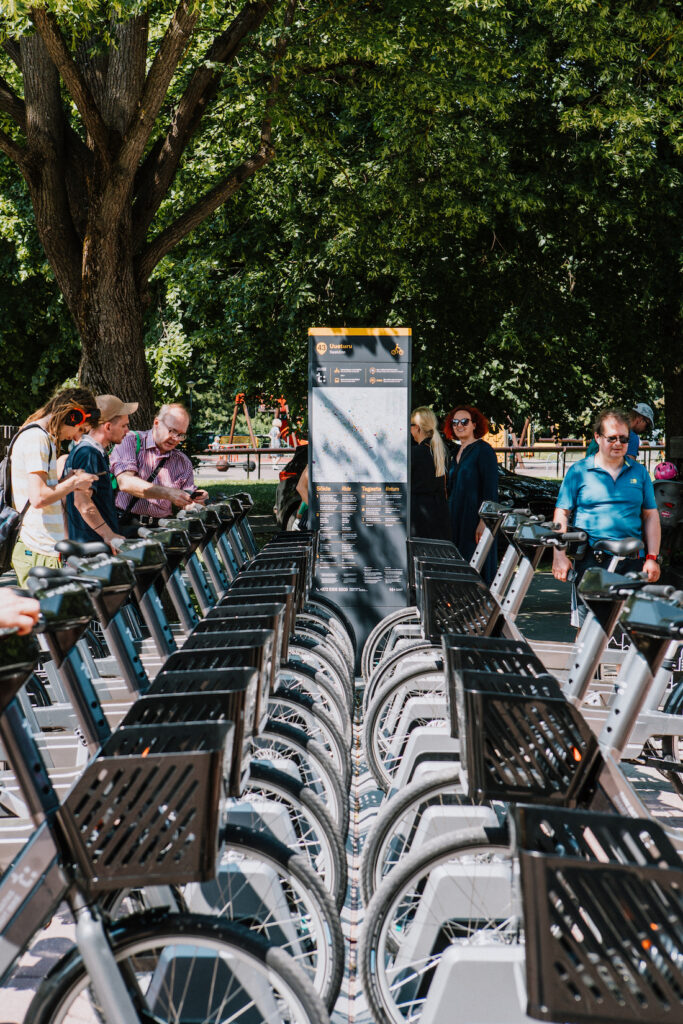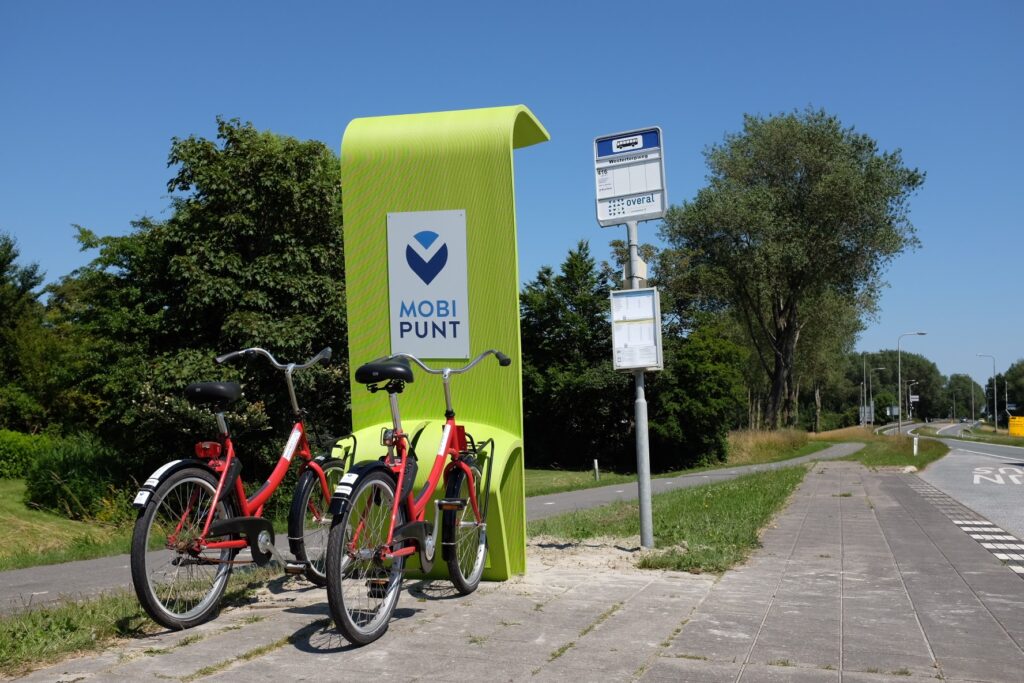The smaller the number of public transport users, the fewer the lines and sparser the timetables, the more difficult it becomes for public transport to compete with individual mobility services. How can we break this vicious circle in view of the climate crisis?
In the past decade, smart mobility solutions and the redistribution of street space among various modes of mobility have become hot topics in urban planning and governance. The given change has been driven by a combination of concurrent circumstances that have made mobility issues relevant for both users and decision-makers.
First of all, the majority of transportation is still dependent on fossil fuels with the European states spending annually more than 200 billion euros on the import of fuels. Alongside the building sector, the transport sector accounts for the highest CO2 emissions. The strategic aim of various countries and cities to become climate neutral either in 15-30 years depending on their location entails, among other things, also the achievement of carbon neutrality of the transport sector. In addition to high carbon emission levels, also the noise and pollution caused by the use of cars have a considerable impact on people’s health.
Secondly, the platform economy has quickly given rise to various mobility services (short-term rental of cars, bikes and scooters, carsharing services etc.) that have considerably reduced the waiting time of the use of the car or other means of mobility and thus also increased their ease of use. Given that in 2015, an average citizen of Tallinn spent around 259 euros on their car maintenance, car ownership and upkeep (insurance, parking, repair) in an area of convenient mobility services may seem unreasonable. Moreover, as the car is used only around 30 minutes per day, it mostly sits idle for the rest of the time.
Thirdly, in the increasingly denser and growing urban environments, also the land used for mobility or parking the vehicles is becoming all the more valuable. Additional space can be reclaimed only by going underground which is usually complicated and expensive. According to a parking study of Tallinn, the gross area for parking and roads in most city districts is twice as much as the gross area for residential buildings. Thus, the question is not so much about the narrowness of sidewalks and bike lanes as about the fact that the densification of the city and the increase of the proportion of green areas (or other public spaces) stand still while the land remains locked under the parked cars.

The increasing need for mobility
Projections into the future paint a compelling picture of the consistent and continuous increase of the need for mobility. According to the forecasts of the business consulting company PwC, the personal mileage in Europe could rise by 23% by 2030 (to 5.88 billion kilometres). This is further driven by the increasing distances between home and work. If in 1998, the average distance from home to work in Estonia was 7.3 kilometres, then in 2017, it had increased to 11 kilometres. At the same time, the number of vehicles in Europe is estimated to decrease by more than 25% by 2030. This can only be achieved if increasingly more rides are made by means of various carsharing services, with new cars bought in future mainly by service providers rather than private users. According to the same PwC forecast, up to 40% of the mileage driven in Europe could be done in autonomous vehicles in 2030.
Less public transport, more mobility services
Various seemingly user-centred mobility services may not actually provide their users with the expected freedom and create new problems instead. The services are so numerous and segmented between various providers using different applications and thus, finding the most economical or convenient service could still be a headache. The main concern here is the increase of mobility poverty, which means that all people cannot use the services as they are not located near their home/work or they lack the financial means to use them.
Historically, public transport has been used to ensure equal modes of mobility, however, the public transport network finds it increasingly difficult to compete with private services striving for individual amenities and faster connections. The smaller the number of public transport users, the fewer the lines and sparser the timetables, the more difficult it is to compete with individual mobility services. How can we break the vicious circle while still offering a diverse set of multimodal mobility options?
As mobility is a complex problem, also the solutions need to tackle problems on various levels. On the one hand, it is important to modernise the public transport services and motivate citizens to make smart use of them. For instance, the programme CitiCAP in the town Lahti rewards its citizens for making green mobility decisions with free services. On the other hand, it is also important to improve the mobility options in the physical space. Are the new residential and commercial districts provided with fast and economical mobility solutions or do they still expect their users to move around with their own car? Dealing with the physical space also requires the reorganisation of the mobility infrastructure, for instance, the creation of mobility points that would bring together various (mobility) services such as a bus stop, parcel machine, carsharing station, recycling point and kiosk.

New urban mobility solutions
For instance, the Finnish Ministry of Transport and Communications has set a triple zero vision for 2050: 0 people or companies in mobility poverty, 0 casualties in traffic accidents and 0 carbon emissions. Achieving the given goal requires a long-term strategic plan implemented by local governments as well as the state and further supported by the required EU regulations. In order to reach the zero vision, it is important to initiate considerable changes in urban planning as well as in comprehensive plans and to support mobility on foot, by bike and public transport. Changing people’s driving habits would require stricter rules for parking norms and taxation, however, drivers are also motivated to opt for carsharing and combined mobility services. Technological solutions in support of the strategy focus on the use of alternative energy sources in transportation, road safety and the deployment of self-driving cars.
Paris is approaching the mobility issues through the location of services with its goal to establish a 15-minute city bringing more life and activities into its city districts and thus also reducing mobility poverty. There have been similar experiments in urban planning such as the 15-minute city, 5-kilometre city or the micro-districts historically familiar to us. In case of Paris, it does not include planning new districts but the readjustment of current quarters into local centres where the families could reach all necessary and optional facilities within fifteen minutes either on foot, by bike or public transportation. The space freed from vehicles will be turned into safe streets, parks and recreational areas.
On a somewhat smaller scale, the establishment of mobility point networks has been undertaken by many European cities (Graz, Vienna, Hamburg, Leuven) with the first feats accomplished thanks to the EU projects rounding up various European cities. A mobility point is a place on the border of several urban regions or in their centre bringing together various services necessary for the local residents. The main content of a mobility point includes mobility services that are supplemented with smart links to other daily services. In the hierarchy of various modes of mobility, they are usually considered a supportive element to the public transport as a so-called last kilometre solution if, for instance, the nearest fast public transport stop (e.g., a train station) is too far. For instance, the design of stops in the Flemish Mobipunt is based on the needs of the place and the available public transport connections. Each mobihub must feature at least a carsharing service, bicycle parking, public transport stop, good lighting and accessibility for all users. It must also be close to other services of the district with all building materials sustainably sourced. There are customised solutions for various urban environments such as for suburbs, industrial parks or town centres. The main advantage of mobility points includes their modular functionality that can be easily customised to particular needs and spaces. They also allow to tidy up the street space as there is now a safe spot for the means of mobility that used to be left randomly in the street.

Mobility solutions in Estonian local governments
Having given a new impetus to the municipal services in just a few years, Tartu and Pärnu seem to have undertaken the most ambitious mobility activities among Estonian local governments. Tartu has reorganised its public transport routes, deployed new buses, established a smart bike sharing and signposting system and begun testing the concept of car-free streets. Pärnu, in turn, has taken its public transportation on the new level in just four years by introducing new environmentally friendly gas buses, digital ticket system and real-time public transportation information. The initiative in Pärnu stands out for its particular focus on public transport stops as the journey’s starting point and destination as well as the business card for the entire system. There is a new central terminal for buses with its seven smaller brothers placed in local centres. The given shelters provide a new quality for regional lines–the bus shelters are warm and equipped with an accessible toilet and bicycle parking area. Several of them have already been supplemented by communal functions such as the village gallery or a branch of the local library. Quick action has been the key in the given municipalities–when the local government has its vision set and key innovations implemented, it is considerably easier to administer and strategically exploit the private mobility service providers entering the market.
From the user’s perspective, the priority in the past and future mobility lies in a smooth journey to its best possibilities and capabilities. Time efficiency will probably remain an important factor also in the future, with the addition of economical and health considerations of the modes of mobility. In all likelihood, mobility services will move to centralised platforms such as the Finnish Whim providing for a monthly fee access to private and public mobility services depending on the user’s needs. In terms of costs, the given packages will always remain more affordable than the maintenance of a private car. The main challenges relate to planning and adapting physical spaces, as linking the current environments with fast public transportation connections takes time and money. Bringing scattered mobility services, parcel machines and other daily services together in particular places requires that municipalities rely on a strong vision and smart coordination.
This work has been supported by the European Commission through the H2020 project Finest Twins (grant No. 856602).

KRISTI GRIŠAKOV is an urban planner and a researcher at TalTech Finest Twins Smart City Centre of Excellence. Her research is focussed on spatial data and the use of future vision development tools such as future scenarios in the strategic planning of cities.
HEADER: Ghent introduced the car-free city centre or circulatieplan in 2017. Cars entering the centre must first register, driving from one district to another is possible only via the ring road, and the new public space for pedestrians and cyclists is painted visibly red. Photo: Mobiliteit Gent
PUBLISHED: Maja winter 2021 (103) Smart Living Enivorment
1 European Parliament. Fossil Fuel subsidies (2017). https://www.europarl.europa.eu/RegData/etudes/IDAN/2017/595372/IPOL_IDA(2017)595372_EN.pdf
2 A European Strategy for low-emission mobility, European Comission https://ec.europa.eu/clima/policies/transport_en
3 Inder Ojamets, „Teadlane: aastas tabab müra tõttu südamehaigus enam kui sadat tallinlast,“ ERR, 15. oktoober, 2020, https://novaator.err.ee/1147206/teadlane-aastas-tabab-mura-tottu-sudamehaigus-enam-kui-sadat-tallinlast
4 TNS Emor, Tallinna liikumisviiside uuring, 2015
5 Heikki Liimatainen, „Disruption of the transport sector – the big bicture and finnish context. CLC’s webinar series on societal disruptions,“ (2020)
6 Damiano Cerrone, Kristi Grišakov, Panu Lehtovuori, Kristjan Männigo, Tallinna linna parkimispoliitika arengusuundade analüüs, (Tallinn: SPIN Unit, 2019)
7 PwC, Five trends transforming the Automotive Industry, https://www.pwc.com/gx/en/industries/automotive/assets/pwc-five-trends-transforming-the-automotive-industry.pdf
8 Statistikaamet, TT232: Põhitöökoha keskmine kaugus elukohast soo ja töölkäimise viisi järgi. Andmebaas (2018)
9 PwC, Five trends transforming the Automotive Industry, https://www.pwc.com/gx/en/industries/automotive/assets/pwc-five-trends-transforming-the-automotive-industry.pdf
10 The PwC forecast does not provide a definition for the concept of autonomous, however, it refers to self-driven vehicles that frees the time currently spent on driving. It may be interpreted as a forecast focussing on creating a vision for the car industry, as depending on the source, there are also various forecasts on the speed of the spread of self-driven cars.
11 Tauri Tuvikene, Marlin Rehema, Dago Antov, „Ligipääsetavuse muutused autostunud Eestis,“ Eesti inimarengu aruanne, toim. Helen Sooväli-Sepping, 2019/2020
12 https://www.lahti.fi/en/housing-and-environment/transportation-and-streets/citicap/
13 Damiano Cerrone, Kristi Grišakov, Panu Lehtovuori et al. ‘Tallinna ja Harjumaa eriliigiliste ühissõidukipeatuste ja ümberistumissõlmede võrgustiku atraktiivsuse tõstmine ja teenusstandardite väljatöötamine’. (Tallinn: SPIN Unit, 2021).
14 Heikki Liimatainen, ‘Disruption of the Transport Sector-The Big Picture and Finnish Context.’ CLC webinar series on societal disruptions (2020).
15 Kim Willsher „Paris mayor unveis 15-minute City plan in re-election campaign.“ The Guardian, 7. veebruar, 2020. https://www.theguardian.com/world/2020/feb/07/paris-mayor-unveils-15-minute-city-plan-in-re-election-campaign
16 https://whimapp.com/





